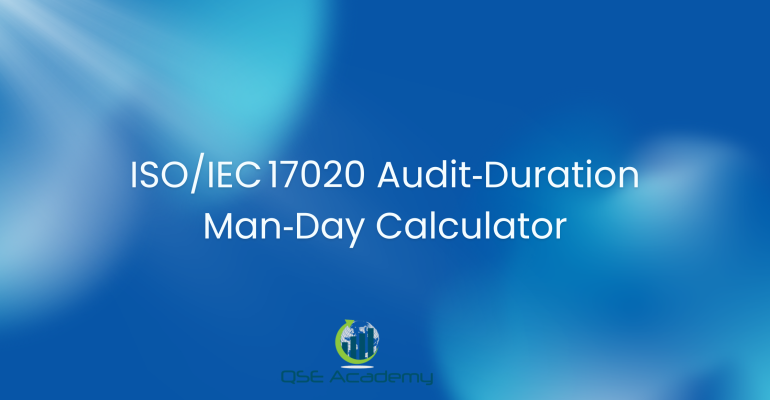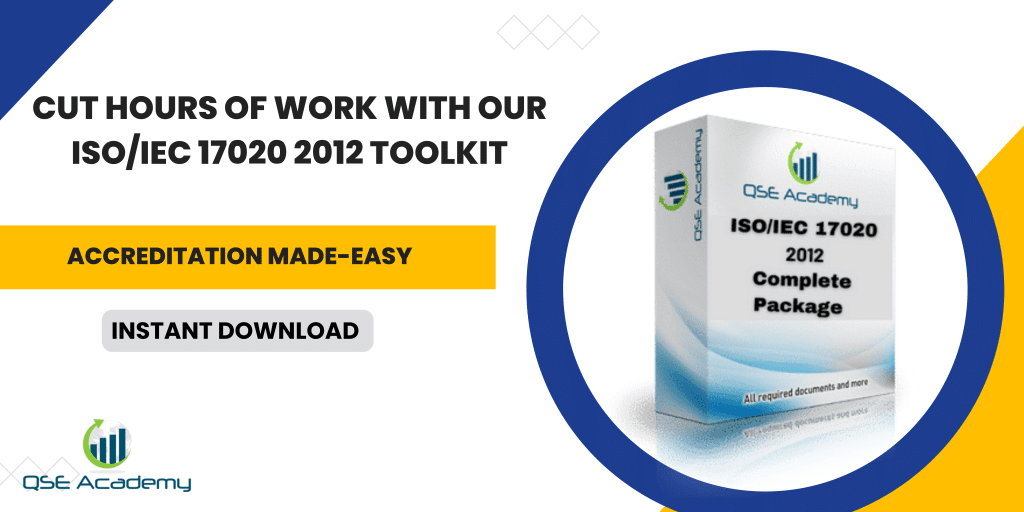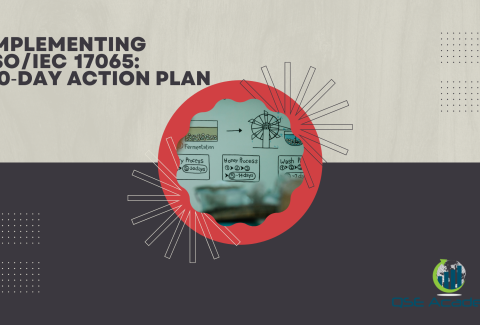ISO/IEC 17020 Audit‑Duration Man‑Day Calculator
Last Updated on October 22, 2025 by Hafsa J.
Understanding ISO/IEC 17020 Audit Duration and Man-Day Calculation
If you’ve ever tried to plan your ISO/IEC 17020 accreditation audit, you’ve probably wondered: How many days will this take? Most inspection bodies underestimate audit duration and end up frustrated when the accreditation body’s quote comes back with far more man-days than expected.
In my experience helping inspection bodies prepare for ISO/IEC 17020 audits, this confusion always comes from the same place—no one really explains how audit duration is calculated. Accreditation bodies don’t pull numbers from thin air; they use specific formulas based on staff size, scope complexity, inspection type (A, B or C), and even the number of sites you operate. Once you understand those inputs, the whole process makes sense—and you can plan far more confidently.
This article walks you through how ISO/IEC 17020 audit-duration man-day calculation actually works. You’ll learn:
-
How accreditation bodies estimate assessment time for document review, on-site evaluation, and witnessing.
-
Which factors have the biggest impact on your audit man-day total (and how to reduce them).
-
How to use a practical ISO/IEC 17020 Audit-Duration Calculator to forecast time, budget, and assessor resources accurately.
By the end, you’ll know exactly how to predict your audit duration before the quote arrives—and use that knowledge to negotiate smarter, schedule better, and control your accreditation costs from day one.
What Is an ISO/IEC 17020 Audit and Why Audit Duration Matters
Let’s clear this up first—an ISO/IEC 17020 audit isn’t just a paperwork check. It’s a complete evaluation of how your inspection body operates, from your documented procedures to the competence of your inspectors and the impartiality of your decisions. The audit confirms that your organization meets the requirements of ISO/IEC 17020:2012 and can deliver technically valid and consistent inspection results.
Here’s how it typically unfolds. The accreditation body (AB) assigns one or more assessors to review your documentation, visit your premises, interview staff, and sometimes witness real inspection activities. Each of these tasks takes time, and that time—measured in man-days—is what determines your audit duration and, eventually, your overall accreditation cost.
Why does audit duration matter so much?
Because it affects almost everything:
-
Budget: The more man-days required, the higher the accreditation cost.
-
Timeline: Longer audits mean more scheduling coordination, travel, and internal preparation.
-
Resources: Knowing the expected audit length helps you allocate your team efficiently.
In my experience, the biggest planning mistake inspection bodies make is assuming that audit duration is fixed. It isn’t. A small inspection body with ten employees and a single site might need just two to three man-days for a surveillance audit. A multi-site organization performing complex inspections under several scopes could easily require five to seven man-days or more.
Pro Tip: Always clarify with your accreditation body how they calculate ISO/IEC 17020 audit duration—some include preparation and reporting time, while others count only on-site assessment days.
Common Pitfall: Don’t confuse calendar days with man-days. A two-day audit with two assessors equals four man-days, not two. That small misunderstanding can double your cost estimate if you’re not careful.
Now that you understand why audit duration is central to both cost and planning, let’s look at how accreditation bodies determine audit man-days—and which factors they use to make that calculation.
How Accreditation Bodies Determine ISO/IEC 17020 Audit Duration (Man-Day Calculation Method)
Here’s what most inspection bodies don’t realize—accreditation bodies don’t guess audit duration. They follow defined criteria, often based on ILAC-G24 or ISO/IEC 17011 guidance, to determine exactly how many man-days are required to evaluate your organization. Once you understand those factors, you can predict your audit time with surprising accuracy.
From what I’ve seen, accreditation bodies typically assess the following variables before setting audit duration:
1. Number of Inspectors or Technical Staff
The more inspectors you employ, the longer it takes for assessors to evaluate competence records, authorizations, and sampling. A 5-person team might need 2 man-days; a 25-person team could need 4 to 6.
2. Scope and Technical Complexity of Inspections
A body that performs simple visual inspections is very different from one conducting nondestructive testing, electrical checks, or pressure-vessel inspections. Each added level of technical complexity increases the required man-days for document review and on-site witnessing.
3. Type of Inspection Body (A, B, or C)
Type A bodies (fully independent) require deeper impartiality evaluations. Type B and C bodies, integrated into parent organizations, need additional checks for conflicts of interest. Both situations affect total assessment time.
4. Number and Location of Sites
If you operate multiple sites, the accreditation body must either visit each one or apply sampling. More sites mean more travel, coordination, and time on-site—especially if they’re in different regions.
5. Risk Level and Inspection Categories
High-risk or safety-critical inspection fields (lifts, cranes, pressure systems) demand longer audits and often extra technical assessors. Low-risk scopes usually take less time.
6. Accreditation Cycle Stage
Initial accreditation audits are always longer than surveillance or reassessment audits. Expect roughly 25–40% more man-days during the initial cycle.
In one case I handled, two inspection bodies of similar size—both with around ten staff—received quotes that differed by almost two man-days. The only difference? One performed high-voltage electrical inspections, which required a specialized assessor.
Pro Tip: Always ask your accreditation body for its audit-duration determination policy. This document outlines how it calculates man-days, and it’s your best reference for forecasting both time and cost.
Common Pitfall: Ignoring witness assessments. Many organizations forget that witnessing actual inspections adds an entire day—or more—to total audit duration.
Now that you understand the variables behind man-day calculation, let’s go one step further and look at the standard ISO/IEC 17020 audit-duration formula, with real-world examples showing how those numbers come together.
Standard ISO/IEC 17020 Audit Duration Formula – How to Calculate Total Man-Days
Now that you know what drives audit time, let’s make it concrete.
Accreditation bodies use structured formulas—based on measurable inputs—to calculate ISO/IEC 17020 audit duration in man-days. Each factor adds (or sometimes reduces) time depending on your inspection body’s size, scope, and complexity.
Below is a simplified version of how a typical ISO/IEC 17020 audit-duration formula works. It’s not universal, but it captures the same logic most accreditation bodies follow.
Table 1 – Example ISO/IEC 17020 Audit Duration Calculation Framework
| Parameter | Base Reference | Adjustment Logic | Example Value | Man-Day Contribution |
|---|---|---|---|---|
| Number of Inspectors / Staff | 2.0 days for up to 10 staff | +0.1 day per additional staff member beyond 10 | 15 staff | +0.5 day |
| Scope Complexity | Simple = Base | Medium = +25%, Complex = +50% | Medium | +0.6 day |
| Number of Sites | 1 site = Base | +0.5 day per additional site | 2 sites | +0.5 day |
| Type of Inspection Body | Type A = Base | Type B or C = +0.25 day | Type B | +0.25 day |
| Witness Assessment | Optional | Add 1 day if required | Yes | +1.0 day |
| Accreditation Cycle | Initial = +1 day | Surveillance = Base | Initial | +1.0 day |
| Total Estimated Audit Duration | — | — | — | 5.85 man-days (≈6) |
This means that for a Type B inspection body with 15 employees, operating on two sites and performing medium-complexity inspections, the accreditation body would likely allocate around 6 man-days for the initial audit.
Table 2 – Typical ISO/IEC 17020 Audit Duration Benchmarks
| Inspection Body Size | Scope Complexity | Typical Audit Duration (Initial) | Typical Audit Duration (Surveillance) |
|---|---|---|---|
| Small (≤10 staff, 1 site) | Low | 2.5 – 3.0 man-days | 2.0 – 2.5 man-days |
| Medium (10–25 staff, 1–2 sites) | Medium | 4.0 – 6.0 man-days | 3.0 – 4.5 man-days |
| Large (25+ staff, multi-site) | High | 6.0 – 9.0 man-days | 5.0 – 7.0 man-days |
Key Insights
-
Document review time and report preparation are often billed separately, depending on the accreditation body.
-
Accreditation bodies round up to the nearest half or full man-day.
-
Using a calculator tool makes these calculations faster and consistent across different scenarios.
Pro Tip: Always verify whether your accreditation body’s man-day estimate includes preparation and reporting. Some ABs bill those separately under “off-site activities,” while others factor them into total audit duration.
Common Pitfall: Comparing man-day totals between accreditation bodies without checking what’s included. A quote for “4 man-days” from one AB might actually cover less work than “5 man-days” from another.
ISO/IEC 17020 Audit-Duration Calculator Tool – How It Works and Why It Matters
Most inspection bodies struggle to estimate their audit duration until the official quote arrives. That’s exactly why tools like an ISO/IEC 17020 Audit-Duration Calculator exist—to bring clarity, consistency, and predictability to your audit planning process.
The calculator follows the same logic accreditation bodies use internally, turning complex criteria into a simple, step-by-step estimation. You input your operational data, and it outputs a realistic forecast of total man-days for your ISO/IEC 17020 audit—including document review, on-site assessment, and witness activities.
Table 3 – Key Inputs for the ISO/IEC 17020 Audit-Duration Calculator
| Input Parameter | Description | Example Entry |
|---|---|---|
| Number of Inspectors / Technical Staff | Total authorized inspectors and technical experts | 12 |
| Type of Inspection Body | A, B, or C as defined in ISO/IEC 17020 | Type A |
| Scope Complexity | Simple / Medium / Complex | Medium |
| Number of Sites | Locations performing inspection activities | 2 |
| Witness Assessment Required | Yes / No | Yes |
| Accreditation Stage | Initial, Surveillance, or Reassessment | Initial |
Once you enter these values, the calculator automatically estimates the total audit duration in man-days, applying weighted logic similar to the model we reviewed earlier.
Example Output:
| Component | Estimated Duration (Man-Days) |
|---|---|
| Document Review | 1.0 |
| On-Site Assessment | 3.0 |
| Witness Assessment | 1.0 |
| Reporting & Follow-Up | 0.5 |
| Total Estimated Duration | 5.5 Man-Days |
Why This Tool Is Useful
-
It provides realistic expectations before requesting accreditation quotes.
-
Helps you budget accurately—you can multiply the estimated man-days by the assessor day rate to project total cost.
-
Enables better scheduling—you can plan staff availability and minimize operational disruption.
-
Supports negotiation with accreditation bodies by giving you a data-backed reference.
In my experience, inspection bodies that use a man-day calculator before applying save time and avoid surprises. When you already know your approximate audit duration, the accreditation body’s proposal becomes transparent and easier to validate.
Pro Tip: Revisit the calculator before each surveillance cycle. Any change in staff count, scope, or number of sites will directly affect your next audit duration and cost.
Common Pitfall: Using outdated data. Always input current employee numbers, active sites, and scope definitions—the tool is only as accurate as the information you provide.
Factors Affecting ISO/IEC 17020 Audit Duration and Man-Day Adjustments
Even with a calculator or formula, ISO/IEC 17020 audit duration can still vary. Accreditation bodies often adjust the estimated man-days based on real-world factors discovered during application review or previous audit performance. Understanding these elements helps you anticipate and manage changes before they become costly surprises.
Table 4 – Common Factors That Influence ISO/IEC 17020 Audit Duration
| Factor | Effect on Duration | Explanation |
|---|---|---|
| Scope Complexity | Increases man-days | Technical or high-risk inspections (e.g., pressure vessels, cranes, NDT) require more assessor time. |
| Number of Inspection Categories | Increases man-days | Each category may need a specialized assessor or witness activity. |
| Geographic Spread / Site Count | Increases travel time | More sites mean more logistics, travel, and coordination. |
| Inspector Competence System | May reduce duration | Strong, well-documented competence systems simplify assessor verification. |
| Past Audit Performance | Can reduce or increase duration | Good track record reduces follow-up time; frequent nonconformities extend audits. |
| Change in Organizational Structure | Increases duration | Mergers, new management, or reorganization trigger deeper reassessment. |
| Remote Assessment Feasibility | May reduce duration | Hybrid assessments can reduce travel days but depend on scope approval. |
Here’s what this means in practice.
I once worked with a medium-sized inspection body that expected a four-day reassessment. But during application review, the accreditation body discovered that they’d added a new inspection category—lifting equipment. That required a second technical assessor and a witness activity, adding two full man-days. Had they run the calculator again with the updated scope, they would’ve planned for it easily.
Pro Tip:
Whenever your organization changes its structure, adds new inspection methods, or opens additional sites, re-run your ISO/IEC 17020 Audit-Duration Calculator. This keeps your internal planning aligned with accreditation-body expectations and prevents unbudgeted extensions.
Common Pitfall:
Assuming remote assessments automatically shorten audits. In some technical fields, assessors still need to witness live inspections on-site to verify competence—especially for safety-critical services. A hybrid model can save travel time but won’t necessarily reduce total man-days.
How to Use the ISO/IEC 17020 Audit-Duration Calculator for Budgeting and Resource Planning
Knowing your ISO/IEC 17020 audit duration isn’t just a compliance advantage—it’s a financial and operational one. The audit man-day estimate you calculate can directly help you plan your budget, staff schedule, and accreditation strategy with much greater precision.
Let’s look at how to turn those numbers into smart decisions.
1. Estimate Accreditation Costs Accurately
Once you know your total man-days, you can easily forecast your audit cost by multiplying it by the accreditation body’s assessor day rate.
Most ABs charge between $1,500 and $3,000 per assessor-day, depending on country and technical scope.
| Example Cost Projection | Calculation | Estimated Cost (USD) |
|---|---|---|
| Document Review (1 man-day) | 1 × $1,500 | 1,500 |
| On-Site Assessment (3 man-days) | 3 × $1,800 | 5,400 |
| Witness Activity (1 man-day) | 1 × $1,800 | 1,800 |
| Reporting & Closure (0.5 man-day) | 0.5 × $1,800 | 900 |
| Total Estimated Cost | — | $9,600 |
By linking audit duration to cost, you can align financial expectations before requesting quotes—and even negotiate more effectively when ABs present their proposals.
2. Plan Internal Resources and Team Availability
Audit preparation requires full participation from your quality manager, inspectors, and technical heads.
If the calculator estimates 5.5 man-days, plan for at least one full workweek of internal involvement. This ensures uninterrupted access for assessors and prevents delays that might stretch your audit timeline (and budget).
Pro Tip:
Integrate audit scheduling into your annual quality calendar. Many successful inspection bodies lock their accreditation timelines early in the fiscal year to balance operational workload and cash flow.
3. Compare Scenarios for Better Decision-Making
You can use the calculator not just once, but iteratively. Try adjusting parameters—like reducing the number of inspection categories or consolidating sites—to see how it impacts man-days and total cost. This approach helps you decide whether certain scope extensions or expansions are worth the additional accreditation effort.
4. Track Changes for Future Cycles
Each surveillance or reassessment audit will differ slightly. Staff growth, new locations, or added inspection types all shift your man-day total.
Re-running your ISO/IEC 17020 Audit-Duration Calculator before each cycle keeps your expectations realistic and avoids last-minute financial surprises.
Common Pitfall:
Many inspection bodies only use man-day estimates during the initial accreditation phase and ignore them afterward. This leads to inaccurate budgeting during surveillance and reassessment years. Treat man-day tracking as a recurring part of your QMS budgeting process.
FAQs – ISO/IEC 17020 Audit Duration and Man-Day Estimation
Q1: What’s the typical audit duration for an ISO/IEC 17020 initial accreditation?
It depends on the size, scope, and complexity of your inspection body, but most organizations fall between 3 to 7 man-days for the initial audit. Smaller, single-site bodies with simple inspection scopes may complete the process in 3 days, while multi-site or high-risk inspection bodies may need 6 or more.
Q2: How often are ISO/IEC 17020 audits conducted?
After the initial accreditation, most accreditation bodies perform annual surveillance audits (about 60–70% of the initial duration) and a full reassessment every five years. The man-day estimate adjusts slightly each cycle depending on your scope, size, and audit history.
Q3: Are witness assessments always required?
No, but they’re common. Accreditation bodies often observe live inspections to confirm technical competence. Whether you need one depends on your inspection category and the availability of suitable activities during the audit window.
Q4: Can remote or hybrid audits reduce total man-days?
They can reduce travel time, but not necessarily the total audit duration. For technical scopes that require on-site verification or witnessing, assessors still need in-person evaluation. Always confirm your accreditation body’s remote-assessment policy before planning.
Q5: How accurate is the ISO/IEC 17020 Audit-Duration Calculator compared to real accreditation quotes?
It’s usually accurate within 10–15%, assuming your input data is current. The calculator reflects the same parameters accreditation bodies use—staff size, sites, inspection types, and complexity—but each AB applies its own rounding rules and policies.
Plan Your ISO/IEC 17020 Audit Duration Strategically
Accreditation success doesn’t just depend on technical compliance—it hinges on smart planning.
Understanding how ISO/IEC 17020 audit duration and man-day calculations work gives you real control over time, cost, and preparation. You can forecast accurately, budget efficiently, and avoid the last-minute stress that catches so many inspection bodies off guard.
Here’s the key takeaway:
-
Know your variables. Staff count, sites, and scope complexity directly shape your audit duration.
-
Use data. A structured calculator eliminates guesswork and provides a transparent reference for both internal teams and accreditation bodies.
-
Plan proactively. Treat man-day estimation as part of your ongoing quality management planning—not just a one-time exercise.
With experience across dozens of ISO/IEC 17020 projects, I can confidently say that organizations who calculate early perform better, spend less, and maintain smoother relationships with their accreditation bodies.
If you’re ready to simplify your next audit cycle, download the ISO/IEC 17020 Audit-Duration Calculator or explore QSE Academy’s ISO 17020 Documentation Toolkit to manage your entire accreditation process—from preparation to audit completion—with confidence and clarity.
I hold a Master’s degree in Quality Management, and I’ve built my career specializing in the ISO/IEC 17000 series standards, including ISO/IEC 17025, ISO 15189, ISO/IEC 17020, and ISO/IEC 17065. My background includes hands-on experience in accreditation preparation, documentation development, and internal auditing for laboratories and certification bodies. I’ve worked closely with teams in testing, calibration, inspection, and medical laboratories, helping them achieve and maintain compliance with international accreditation requirements. I’ve also received professional training in internal audits for ISO/IEC 17025 and ISO 15189, with practical involvement in managing nonconformities, improving quality systems, and aligning operations with standard requirements. At QSE Academy, I contribute technical content that turns complex accreditation standards into practical, step-by-step guidance for labs and assessors around the world. I’m passionate about supporting quality-driven organizations and making the path to accreditation clear, structured, and achievable.











